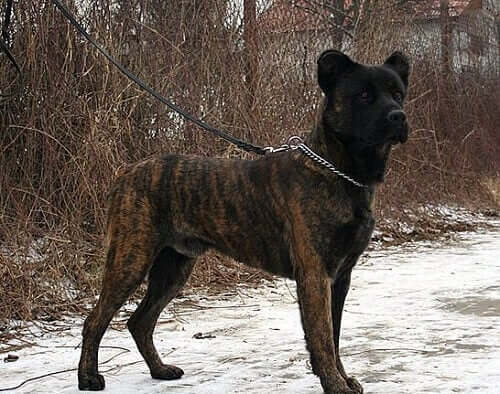Meet the Saint Miguel Cattle Dog

The Saint Miguel cattle dog breed is one of the least known anywhere outside its country of origin, Portugal. As the name suggests, it has been mainly used as a cattle dog. Today, this breed isn’t assuming this role as much, due to livestock industry modernization. Therefore, the Saint Miguel has become a companion dog instead.
Origins of the Saint Miguel cattle dog
Called “Fila de São Miguel” in Portuguese, this breed originated on the island of São Miguel in the Azores archipelago, Portugal. It’s a descendant of the already extinct “Terceira” and the “Castro Laboreiro” dog, introduced on the island during the sixteenth century.
The Saint Miguels are quite large dogs, designed for grazing large animals such as cattle. This, in turn, has earned them the nickname of “cowdogs” on the island. Outside of this, the breed is gaining ground all over Europe. However, it was in the year 1984 when the breed’s first standard evaluations took place.
Physical aspects and appearance
This breed belongs to the Molosser type: dogs designed to have a powerful bite, ideal for tasks of any kind. Their greatest highlight is their coat, which is quite particular because of its fawn-like pattern stripes. Below are some other outstanding characteristics of this breed:
- It has a large skull that stands out from its body
- Its muzzle is a little shorter in relation to the head’s length
- The lower jaw is shorter than the upper jaw; nevertheless, it’s capable of delivering a formidable bite
- Its nose is large and black
- The eyes are round and small, separated from each other
- The ears are located at the eye level and naturally hang down
As for its build, it should be noted that its body is muscular and light. This is ideal for running under pressure and endurance challenges:
- The average weight is about 77 lbs, with females slightly smaller
- Its height is a maximum of 23.6 ins at the withers
- The chest is large and wide and it has a straight back
- Its limbs are long and strong, ideal for any terrain type
- The tail is long and usually uncut as this is a practice that is now being banned throughout the world
- Its skin is thick and has a short, smooth coat with a rough texture
In short, we’re talking about a powerful dog designed for the countryside. Its most interesting attributes are its great power and energy to run for hours, as well as the ability to adapt to any kind of terrain.
Behavior and temperament
The Saint Miguel is a dog designed for cattle farming, which means it possesses great intelligence to perform this task. This dog is able to take care of the herd with great diligence. In addition, it will lead the herd with firmness and steadiness on some occasions, as they can bite the cows gently on their legs.
Moreover, its intellect also allows it to enjoy family time. The Saint Miguel is a very kind and affectionate animal with all family members. It’s also a good guard dog as it likes to make perimeter rounds with great bravery and confidence.
It will often act with caution and coldness with strangers. Usually, it will remain alert to any aggressiveness or sudden changes on the stranger’s part. In the case of other dogs, it tends to have a dominant character, so if it’s not properly socialized at an early age, it can become problematic.
Expert trainers regard this dog to be gentle and even docile when trained well.
Training
This is a dog that’s suitable for the countryside and dog experts don’t recommend it for urban environments unless its human family is a very active one. This is because it needs a lot of exercise and a large space to be able to run freely. Thus, not having these elements can result in unwanted behavior, such as nervousness, aggression, and destructive tendencies.
It isn’t a breed for first-time trainers due to its dominant attitude. The best approach is that of an expert, yet friendly, hand, which will show the dog how to behave properly.
Health and diseases
Being a dog of considerable size, the Saint Miguel cattle dog presents classic diseases that affect large dogs. Such diseases are hip dysplasia and stomach twisting, for instance. Careful attention should be paid to the dog’s eyes because of the moisture that can build up in them, as these conditions are ideal for fungi and other bacteria to develop.
As for its fur care, daily brushing will be more than enough to remove the dead hair from its coat. Similarly, areas with creases or areas that are in permanent contact with the ground should be carefully cleaned periodically.
Last but not least, the dog’s legs should also be carefully examined regularly since that’s where they most often get hurt. It’s common for external elements to get tangled or become stuck on their legs. In addition, the appearance of ticks is a somewhat delicate matter because they transmit piroplasmosis.
In regards to their diet, it’s better if they eat in a balanced way as they are prone to becoming overweight.
We hope you enjoyed today’s article and learned more about the dear friends and companions. Until the next time!